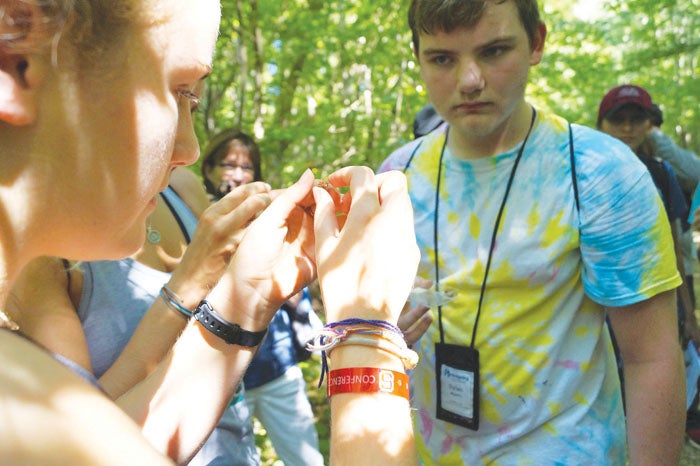Annual summit at Catawba College gives high school students the chance to learn about the environment
Published 12:00 am Thursday, July 12, 2018

- Jane Slentz-Kesler examines a cockaburr before she sticks it to her shirt. Anna Grace Thrailkill/For the Salisbury Post
SALISBURY — Students gathered at Catawba College’s Center for the Environment on Wednesday to take part in the National Environmental Summit for High School Students.
The camp’s mission is to teach students about the environment and how to support it.
Thirty-one students took part in the camp this week. This is the eighth annual National Environmental Summit at Catawba. The theme for this year is “Redesigning Our Future.”
John Wear, the center’s executive director, said the camp was started because students were coming to him with an interest in how to best sustain the environment.
“They had a strong sense of stewardship for the environment,” said Wear.
Wear said the camp has given students an avenue for developing a deeper understanding about the environment, even if they aren’t going into a career field related specifically to that.
Activities of the week include listening to speakers in fields related to ecology and research, exploring Catawba’s 189-acre ecological preserve, and being trained to apply what they are learning about the environment in their schools and communities.
The camp is hosting speakers who will talk about digital communication, art and community.
On Wednesday morning, students at the camp took part in an activity related to biomimicry. Biomimicry is the study of how organisms in nature behave and applying that knowledge to current technology and innovation.
Before going on a walk outside, students listened to Matt Hendricks, Catawba’s preserve keeper, talk about biomimicry and how it has benefits for everyone.
“Nature has years of experience that we can learn from,” said Hendricks.
After listening to Hendricks, groups of students ventured into Catawba’s ecological preserve to discover examples of biomimicry. Students used geocachers to locate different stations in the woods that had information and examples of the topic.
Stations scattered around the woods held different organisms and objects like butterflies, salamanders, cockaburrs and spider webs. The stations held papers explaining how these objects have been used for biomimicry.
An example of biomimicry is that the makeup of spider webs inspired the design of bulletproof vests. Another fact that the students learned is that the stickiness of cockaburrs fueled inventions like Velcro.
Jane Slentz-Kesler, a student from Durham, said she heard about the camp from an organization she is involved in. Someone approached her about providing a scholarship so she could attend the camp, and Slentz-Kesler quickly agreed.
Slentz-Kesler said the best thing about the camp was meeting so many people. She enjoyed building relationships with fellow students and connecting with those who work in environmental fields.
“I love that there are different people that I can talk to about so many things,” said Slentz-Kesler.
Cathy Green, director of operations at the Center for Environment, said she has seen many students connect with faculty and college staff members, and she encourages them to network and talk to anyone there.
“Students not only learn what camp life is like, but they also get to hear about different careers,” said Green.
Overall, the students are passionate and excited to learn about the environment.
Matt Hendricks has been involved in the camp since it started. He said he enjoys explaining how to apply the knowledge the students are learning into their lives.
“It’s all about learning from nature,” said Hendricks.




